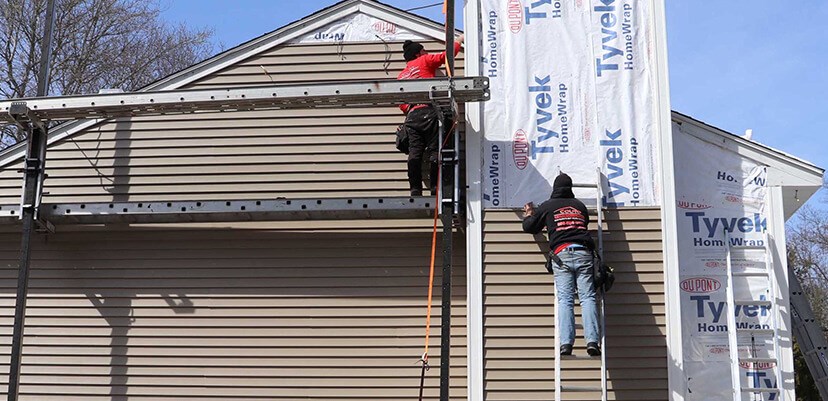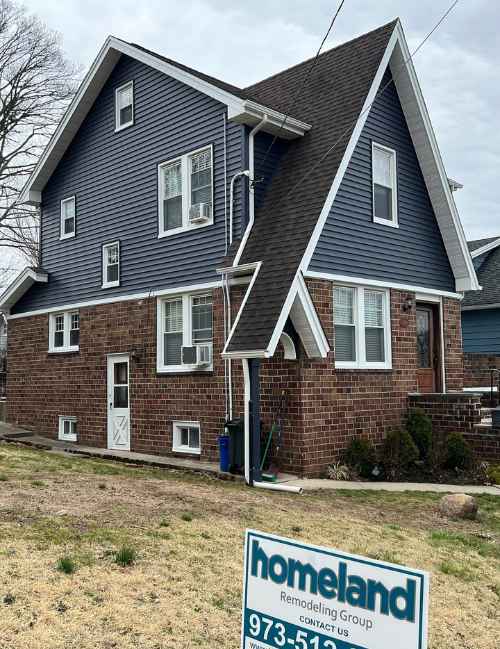The Important Overview to the Numerous Kinds of Exterior Siding and Their One-of-a-kind Advantages
In the realm of home enhancement, picking the right home siding is a vital decision that affects both aesthetic charm and practical performance. The variety of materials readily available, such as wood, plastic, fiber steel, brick, and concrete, each deal unique benefits that deal with different demands and choices. Comprehending these differences can dramatically enhance the long life and worth of a home - morris siding contractor. Nonetheless, with many options to take into consideration, which house siding material truly sticks out for your specific task? Discovering these options can cause informed choices that line up with both style and practicality.
Timber Exterior Siding
Wood house siding, a preferred option for household outsides, provides a classic visual that combines all-natural beauty with structural stability. This home siding material is readily available in various styles, including clapboard, roof shingles, and board-and-batten, permitting homeowners to customize their appearance to match their layout preferences. Wood house siding is commonly crafted from resilient types such as cedar, redwood, or pine, which are understood for their strength and capacity to hold up against ecological stress factors.
Among the primary benefits of timber exterior siding is its outstanding insulation homes, which can contribute to energy effectiveness and reduced heating costs. Furthermore, timber exterior siding is eco-friendly, making it an eco-friendly choice when sourced sustainably. Normal upkeep, consisting of paint or staining, can prolong its life-span and improve its look, allowing house owners to protect the natural appeal of the timber.
However, potential disadvantages consist of susceptibility to parasites, rot, and climate damages, necessitating adequate therapy and maintenance - morris siding contractor. Regardless of these concerns, when effectively cared for, timber house siding can offer a lovely and resilient solution that boosts the character of a home while using a warm, inviting ambience

Vinyl Siding
Plastic siding has actually emerged as a leading choice for house owners looking for a low-maintenance exterior option that incorporates durability and affordability. This flexible product is crafted from polyvinyl chloride (PVC), making it resistant to various climate condition, consisting of moisture and UV rays. Consequently, vinyl home siding does not warp, rot, or discolor, making sure long-lasting visual charm.
One of the primary advantages of vinyl house siding is its substantial series of shades and designs, allowing home owners to attain the preferred search for their residential property without the need for constant repainting. Furthermore, plastic exterior siding is easy to set up, which can considerably reduce labor prices during building or improvement tasks.
Plastic exterior siding likewise adds to power efficiency. Lots of alternatives attribute insulation backing, which improves thermal performance, aiding to preserve comfy indoor temperature levels and potentially lowering energy expenses. Its smooth surface area facilitates very easy cleaning, requiring just regular washing with a garden hose pipe to get rid of dirt and debris.
Fiber Cement Siding
Fiber cement exterior siding has actually acquired grip amongst building contractors and home owners alike due to its remarkable mix of toughness and aesthetic versatility. Composed of a mixture of cellulose, sand, and cement fibers, this home siding choice is engineered to endure extreme climate conditions, consisting of high winds, hefty rain, and temperature level changes, making it a durable selection for household exteriors.

Among the key benefits of fiber cement home siding is its resistance to insects, such as termites, and its non-combustible nature, offering improved fire safety. morris siding contractor. Furthermore, it is readily available in a vast variety of colors, designs, and structures, allowing property owners to attain their wanted visual without giving up performance
Another benefit is its low maintenance requirements; fiber concrete house siding normally needs paint or discoloration every 5-10 years, which is less constant than other products. Its longevity contributes to a reduced overall expense of ownership, as it minimizes the demand for regular repairs or substitutes.
Inevitably, fiber concrete siding represents an excellent investment for those looking for a resilient, eye-catching, and versatile exterior choice, integrating both type and function to boost the home's curb charm.
Metal Home Siding
The appeal of metal siding depends on its durable sturdiness and modern-day visual charm, making it a favored selection for modern architecture. Available in products such as light weight aluminum and steel, steel siding uses a series of coatings and shades, allowing home owners to achieve a customized look that complements their style vision.

Energy performance is an additional considerable benefit, as numerous steel home this website siding items are created with insulation choices that aid manage interior temperature levels. This can cause reduced energy prices with time. Additionally, steel house siding is usually recyclable, making it an eco-friendly selection for sustainability-minded property owners.
The installment process for metal siding can be relatively simple, resulting in a quicker turnaround time for construction tasks. In general, steel home siding integrates capability and style, making it a useful choice for those seeking a long-lasting and visually enticing outside surface.
Block and Rock House Siding
Block and stone exterior siding attracts attention as a timeless selection that enhances the visual charm of any type of home. Recognized for their sturdiness and reduced maintenance, these products supply an outstanding return on financial investment while raising the property's aesthetic allure. Available in various shades, appearances, and patterns, brick and stone can be customized to fit varied building designs, from typical to modern-day.
Among the key benefits of block and stone home siding is their power performance. Both products possess all-natural insulating buildings that help control interior temperatures, potentially decreasing heating and air conditioning prices. Additionally, they provide premium fire resistance compared to other home siding alternatives, adding to improved safety.
Another benefit is their durability. Block and rock can last for decades, typically needing very little maintenance past occasional cleansing. Unlike wood home siding, they are unsusceptible insects and rot, ensuring a lasting exterior that stands up to the elements.
Verdict
In summary, the option of house siding substantially impacts a home's aesthetic charm, power effectiveness, and upkeep requirements. Each sort of siding-- whether wood, plastic, fiber metal, brick, or click for more info concrete and rock-- provides one-of-a-kind benefits tailored to numerous homeowner preferences and ecological conditions. Recognizing these choices allows informed choices that boost both the durability and aesthetic appeal of property exteriors. Inevitably, selecting the right home siding is crucial for achieving an equilibrium in between functionality and layout in household design.
One of the primary benefits of timber siding is its exceptional insulation residential properties, which can add to energy effectiveness and lower home heating expenses. Furthermore, timber exterior siding is naturally degradable, making it an eco pleasant choice when pop over to this web-site sourced sustainably.One of the primary advantages of metal siding is its resistance to various ecological elements.Power efficiency is another considerable benefit, as several steel house siding products are made with insulation alternatives that assist regulate interior temperatures. Each kind of home siding-- whether timber, plastic, fiber metal, cement, or block and stone-- offers one-of-a-kind benefits tailored to various property owner choices and ecological problems.